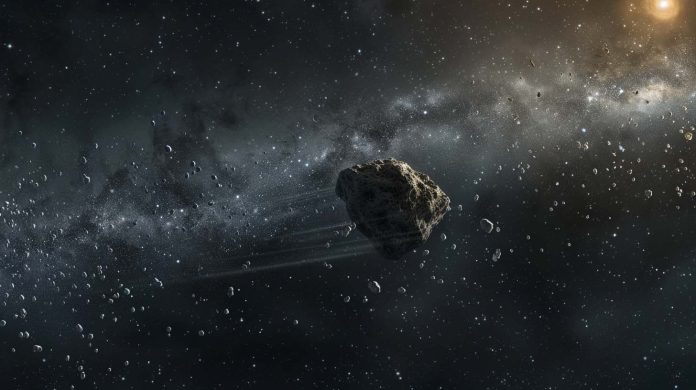
Up to 60% of near-Earth objects might be dark comets—mysterious asteroids that likely contain or once contained ice.
These dark comets orbit the sun and could have played a role in delivering water to Earth, according to a University of Michigan study.
Asteroids in the asteroid belt, located between Jupiter and Mars, have long been suspected to have subsurface ice.
Aster Taylor, a graduate student in astronomy at the University of Michigan and the lead author of the study, suggests that these dark comets could be a pathway for bringing ice into the near-Earth environment.
Understanding how Earth got its water is a longstanding mystery, and this study provides new insights.
Dark comets are intriguing because they combine features of both asteroids and comets. Asteroids are rocky bodies without ice that orbit close to the sun. Being within the “ice line” means any ice they might have had would have sublimated, turning from solid to gas.
Comets, on the other hand, are icy bodies that develop a fuzzy coma—a cloud of gas and dust—when they approach the sun.
This sublimation process also causes comets to experience slight accelerations, not due to gravity but to the sublimating ice.
The study examined seven dark comets and estimated that between 0.5% and 60% of all near-Earth objects could be dark comets. These dark comets don’t have comae but do show nongravitational accelerations. This suggests that the asteroids in the asteroid belt contain ice.
Taylor and his team wanted to find out where these dark comets came from. Their research suggests that one large dark comet might originate from the Jupiter-family comets, whose orbits bring them close to Jupiter. The study, published in the journal Icarus, indicates that dark comets likely come from the asteroid belt.
The researchers used dynamical models to assign nongravitational accelerations to objects from different populations and modeled their paths over 100,000 years.
They found that many of these objects ended up where dark comets are now, suggesting the asteroid belt as the most likely source.
One dark comet, 2003 RM, has an elliptical orbit that brings it close to Earth, then out to Jupiter, and back past Earth. This orbit is consistent with a comet that was knocked inward from its original path.
The study suggests that while 2003 RM might have come from the outer main belt of the asteroid belt, the other dark comets likely came from the inner main belt. This shows that ice is present in the inner main belt.
The researchers also explored why dark comets are small and rotate quickly. Comets are like dirty ice cubes—rocky structures bound by ice.
When they get bumped within the solar system’s ice line, the ice starts to off-gas, causing acceleration and rapid spinning. This spinning can cause the comets to break apart. As they break into smaller pieces, these fragments continue to lose ice, spin faster, and break apart further.
Taylor explains that this process results in the small, fast-rotating objects we see. Larger dark comets, like 2003 RM, may have been bigger objects that got knocked out of the outer main belt. The other smaller dark comets likely came from the inner main belt, created by larger objects breaking apart.
This study brings us a step closer to understanding the mysterious dark comets and their role in our solar system. While it’s not certain if they delivered water to Earth, the research opens up new possibilities for how ice could travel through the solar system, shedding light on the complex history of our planet’s water.



